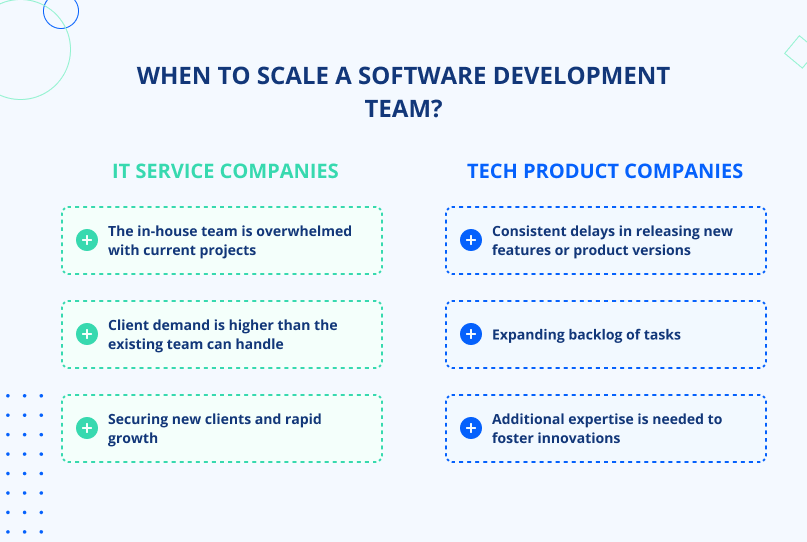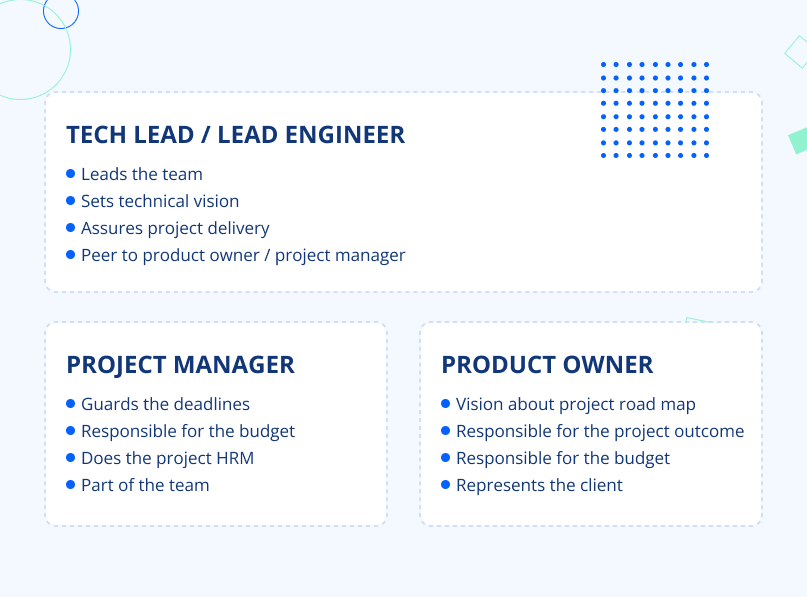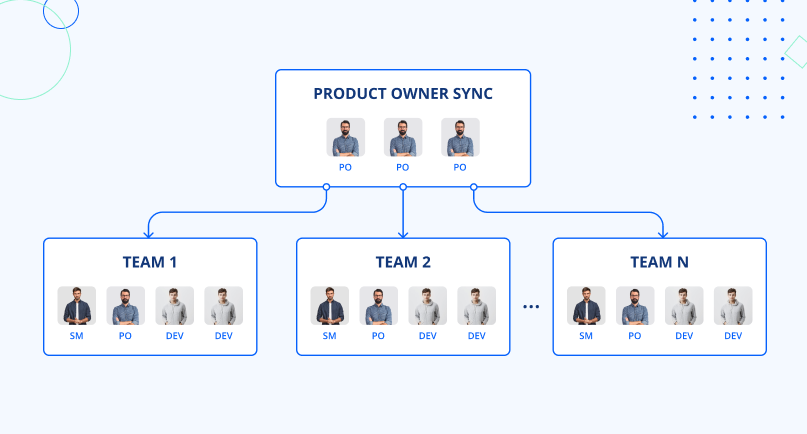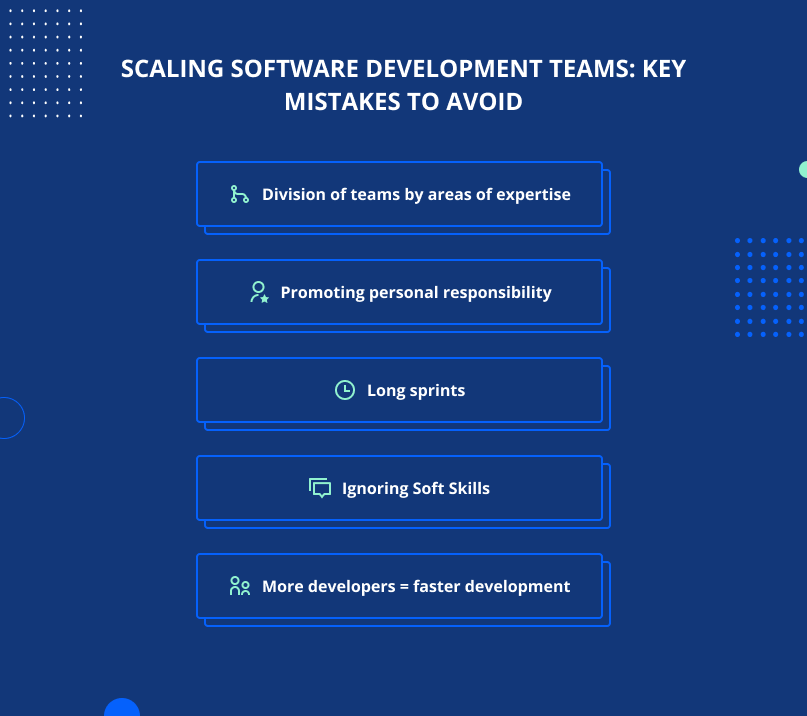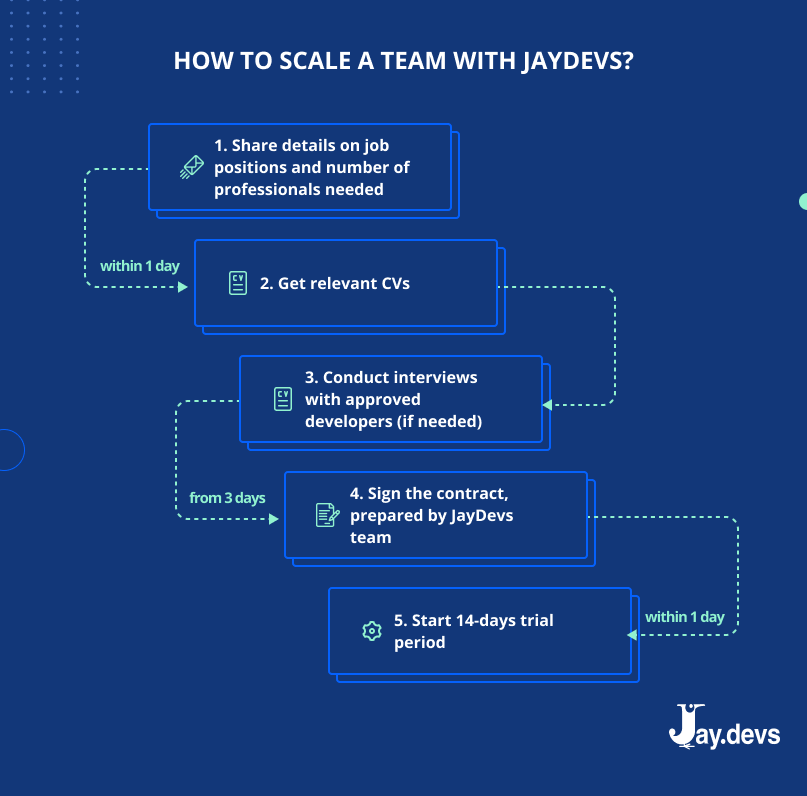After you organize the work of a small and agile team that delivers results, the next logical step may involve scaling your software development team. However, expanding and coordinating software development processes for larger teams is not a piece of cake.
In this guide, we’ll explore key considerations for scaling a technical team, including business drivers and aspects that require careful attention so that scaling is successful.
Why Scale Up a Development Team?
Scaling a technical team is directly related to business performance. Reaching certain milestones, such as securing a second round of investments or experiencing significant growth in customers, often indicates you need more human resources to propel your company forward.
As a decision-maker, pose a few questions to understand whether your business is ready for team extension:
- Is my project/product anticipating significant and ongoing changes?
- Will scaling and expediting the software development process have a direct impact on profitability?
- Does my company have enough time and money to initiate a team extension?
In essence, scaling a software development team is a proactive response to business growth and the pursuit of ambitious goals.
When to Scale a Software Development Team?
Determining the right moment to scale depends on the nature of your business. Whether you’re the owner of a service company or a tech product startup, recognizing these clear signals can save you valuable time and resources.
For service companies offering software development expertise, scaling technical teams is closely linked to managing client demand. Here are specific indicators that signify it’s time to scale:
- The current team consistently struggles with an overwhelming workload, making it difficult to meet project demands.
- The volume of client requests exceeds the production capacity.
In the case of product companies, the size of the development team and their technical expertise often determine the speed of product development and its value proposition. This scenario presents its own set of scaling triggers:
- The company struggles with frequent delays in project releases.
- New product concepts emerge regularly, leading to an ever-expanding backlog of tasks.
- The product requires additional expertise or a broader skill set to maintain competitiveness and drive innovation.
If your business aligns with any of these cases, it’s absolutely clear that it’s time to scale your software team.
However, it’s crucial to approach this process methodically to prevent potential drops in efficiency, cost increases, and disruptions to your business operations. Let’s delve deeper into the steps necessary to prepare for a seamless scaling journey.
Preparing for Scaling: A Business Standpoint
1. Clarify Business Essentials
Before scaling up, define your business’s core elements, including mission, vision, and culture. These are guiding principles that help a company’s team work together and reach business goals.
They will help you define your company’s potential and create a strong foundation to confidently navigate the business growth process.
2. Set Your Strategy and Metrics
Scaling without a clear vision can lead to rushed decisions and financial setbacks. So, it’s better to align your scaling efforts with your company’s development strategy.
Set performance metrics for each department to track progress and ensure everyone is on the same page. For example, at JayDevs, we create a three-year growth plan, synchronize workflows across departments, and hold bi-annual meetings to review and adjust our strategy.
3. Appoint Product and Project Leaders
As your projects multiply, consider assigning additional roles like product owners, project managers, and lead engineers.
Such an approach ensures key product-related tasks are in capable hands during scaling. Additionally, lead specialists significantly support this process, as they typically manage technical teams and help in bridging talent gaps.
4. Define the Team Size Limits
Scaling inevitably reshapes the structure of your company. And clearly, it’s easier to manage small teams.
To navigate this transformation without complications, decide on minimum and maximum team sizes (ideally between 7-10 people). If your team grows beyond the range, consider splitting it into smaller units.
Tip: You can apply the “rule of two pizzas,” coined by Jeff Bezos. This simple guideline suggests that a team should be small enough to be fed with two pizzas.
5. Foster Team Independence
Small teams are the backbone of flexible scaling. However, the number of teams should not grow without careful thought and planning.
Creating separate teams that are highly dependent on one another may cause communication and management issues. Therefore, ensure each team can deliver project increments autonomously or at least with minimal dependencies.
6. Optimize Communication Channels
Organizational changes mean it’s time to review how you communicate, especially with remote team members.
Clear and smooth communication is essential when scaling up a development team. To cut down the digital noise, revise communication tools so that each team member receives the necessary information promptly.
Read more: Top 19 Tools for Remote Work With a Development Team.
7. Streamline Talent Recruitment
Without the right team, the tips mentioned above won’t work as expected.
Partnering with a strategic recruitment partner can significantly enhance your talent acquisition efforts. These partners bring expertise in identifying and attracting top talent, aligning candidates with your company’s culture, and assessing their fit within your teams. Moreover, they can help you navigate the challenges of scaling by providing insights into industry trends, salary benchmarks, and best practices in recruitment.
As businesses navigate the complexities of scaling, partnering with experts in talent recruitment can provide invaluable support. Companies like JayDevs specialize in talent tech recruitment, offering insights, strategies, and resources to streamline the hiring process and attract top-tier talent. From crafting compelling job descriptions to assessing candidate suitability and integrating new hires seamlessly into the team, these recruitment experts play a pivotal role in ensuring that businesses have the right talent in place to fuel growth and innovation.
Tip: Hire individuals who fit well into the team, and integrate them iteratively.
8. Consider IT Staff Augmentation
Staff augmentation provides the flexibility to scale your team up or down based on project requirements without the long-term commitment associated with traditional hiring. This agility is particularly beneficial during periods of rapid growth or fluctuating workloads.
External engineers brought in through staff augmentation often bring a diverse range of specialized skills and experiences. This allows your team to access niche expertise that may not be readily available internally, enhancing the quality and innovation of project deliverables.
While scaling requires augmenting your team with external talent, it’s essential to preserve the core dynamics and cohesion of your existing team. Staff augmentation companies like JayDevs allow you to supplement your team with additional resources without disrupting established workflows or team dynamics.

Note: External developers complement your in-house team, not replace it.
9. Explore External Dedicated Teams
As your projects grow in complexity and scope, internal scaling efforts may reach their limits. In such scenarios, exploring external dedicated teams can offer a viable solution to bridge the gap and propel your business forward.
Internal scaling efforts are essential for nurturing talent and expanding capabilities within your organization. However, there are instances when project requirements exceed internal capacities. External dedicated teams provide a scalable solution to augment your workforce quickly and efficiently.
By tapping into external talent pools, you gain access to specialized skills and expertise that may not be readily available internally. Whether you need additional software developers, designers, or project managers, external dedicated teams offer a flexible and cost-effective way to bolster your project teams.
Complex projects often require a diverse set of skills and resources to execute successfully. External dedicated teams bring a wealth of experience and industry knowledge to the table, enabling you to tackle even the most challenging initiatives with confidence.
Read more: Dedicated Software Development Teams: The Four W’s
10. Synchronize the Work of the Teams
Scaling product development teams may present coordination challenges, especially when they’re distributed across time zones and locations.
For example, one team might finish their project sprint while another is still in progress. This situation could hinder the entire development process, given that all the parts are linked together.
To overcome the issue, sync the workload and scale the teams based on their capacity. Collaborate with team leaders (and IT vendors) to reallocate resources as needed.
Preparing for Scaling: Technical Standpoint
11. Plan Product Infrastructure and Architecture
Scaling software development teams alone aren’t enough if app infrastructure and architecture are not well-conceived.
You might run into problems when developing new features, realizing that your infrastructure can’t handle the increased load, or that certain parts of your application stop working.
Before scaling, think ahead about the design of the scaled product. This will also help you determine the necessary human resources.
12. Automate Development Processes
Scaling becomes tricky with manual tasks. As your development team grows, some tasks get expensive and less effective.
For instance, think about integrating CI/CD practices into product development. This will help your team to automate code testing and deployment, and cut down on manual work.
With automation, you’ll be able to allocate resources better and scale efficiently.
13. Stay Agile in Project and Product Management
As your team count grows, the importance of effective project and product management becomes paramount. To manage teams efficiently in a changing environment, use proven Agile methodologies.
One of them is Kanban. It is ideal for visualizing the development process, where each team member sees what needs to be done and when. When combined with daily meetings, this helps ensure that the workload is evenly distributed among the employees.
Ultimately, the choice of a methodology should be based on project specifics. Use our guide to key methodologies to choose the most appropriate one.
14. Apply Coding Best Practices
Poor code quality can quickly turn into a nightmare when scaling software development teams. New team members may spend days or even weeks trying to understand the logic or key dependencies, instead of rolling out the new features.
Clean and readable code is like a common language that all engineers can understand, facilitating smoother collaboration. In this context, development teams should conduct a comprehensive code review to prepare the product codebase for scaling.
Tip: Make code reviews a regular practice for your products and projects. This will help to scale more effectively with fewer complexities.
15. Use Pair Programming
To simplify the integration of new team members, think about implementing pair programming.
This method involves experienced engineers co-working with newcomers during their initial weeks. Working together allows new teammates to grasp the company’s processes, tools, and coding style faster.
Avoid pairing newcomers with the top developers who are deeply engaged in core tasks. While senior developers have a wealth of knowledge to offer, they’re too advanced beyond “novices” and may overlook simple but highly important communicational points. Consider finding a developer with mentoring skills instead.
Note: People should be comfortable working together; personal qualities and temper should be considered when pairing developers, otherwise the approach won’t be effective.
Scaling Software Development Teams: Key Mistakes to Avoid
Avoid Division by Areas of Expertise
Dividing teams to the front-end, back-end, or similar can be a bad idea, as you won’t have a single team that can fully deliver a functional product part. This adds complexity to communication and makes teams dependent on each other.
Promote Collective Responsibility
It’s natural for each employee to be accountable for their tasks and areas of expertise. Issues can arise when half of the team has their work done and while another half is still working.
Ensure everyone understands they are collectively responsible for delivering their part of the product, fostering a sense of teamwork.
Optimal Sprint Length
Long sprints break the rhythm of development.
The optimal sprint length is two weeks. Such sprints provide quick feedback loops and changes in the project, which is especially important for startups. They also give a sense of gradual, constant progress, which leads to faster results.
Soft Skills Matter
Undoubtedly, hard skills are important, especially in technical positions, such as a developer and quality assurance engineer, however, don’t underestimate soft skills.
Flexibility, teamwork, curiosity, and the ability to solve non-standard tasks are also important, especially when the company is growing actively.
When scaling, your teams will continuously change, having new people on board. Therefore, it is important to select candidates with good adaptability and strong communication skills.
More Developers Does Not Guarantee Faster Development
This fallacy often occurs in “non-techies.”
Application development is like building a house. Up to a certain point, the increase in the number of developers speeds up development, but it has a limit.
Some models show how to optimally allocate resources during the project. One of them is the scheme for allocating resources during the project following the theory of B. Boehm (*COCOMO). It helps to calculate effort, cost, and schedule for projects.
Conclusion
Scaling your software development team is a complex process deeply intertwined with your company’s growth and success. It reflects how well your company is already structured and reveals issues that are not visible with a small number of employees.
For scaling to go smoothly, you need to establish a strong foundation with a clear mission, vision, and culture. Embrace efficient processes in project and product development, along with a technical base ready for scaling. By following the 15 tips discussed, you can successfully pass through the scaling stage and achieve your goals.
If you are searching for rapid and budget-friendly options to scale up your development team, JayDevs is here to assist you.
We can extend your team with lead and senior engineers, DevOps, and QA professionals. Our specialists seamlessly integrate into your team, striving to be a full-fledged part of it, not people who simply receive tasks.
Contact us to learn more about our services and the availability of engineers.




